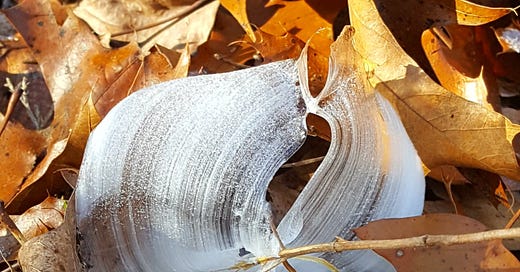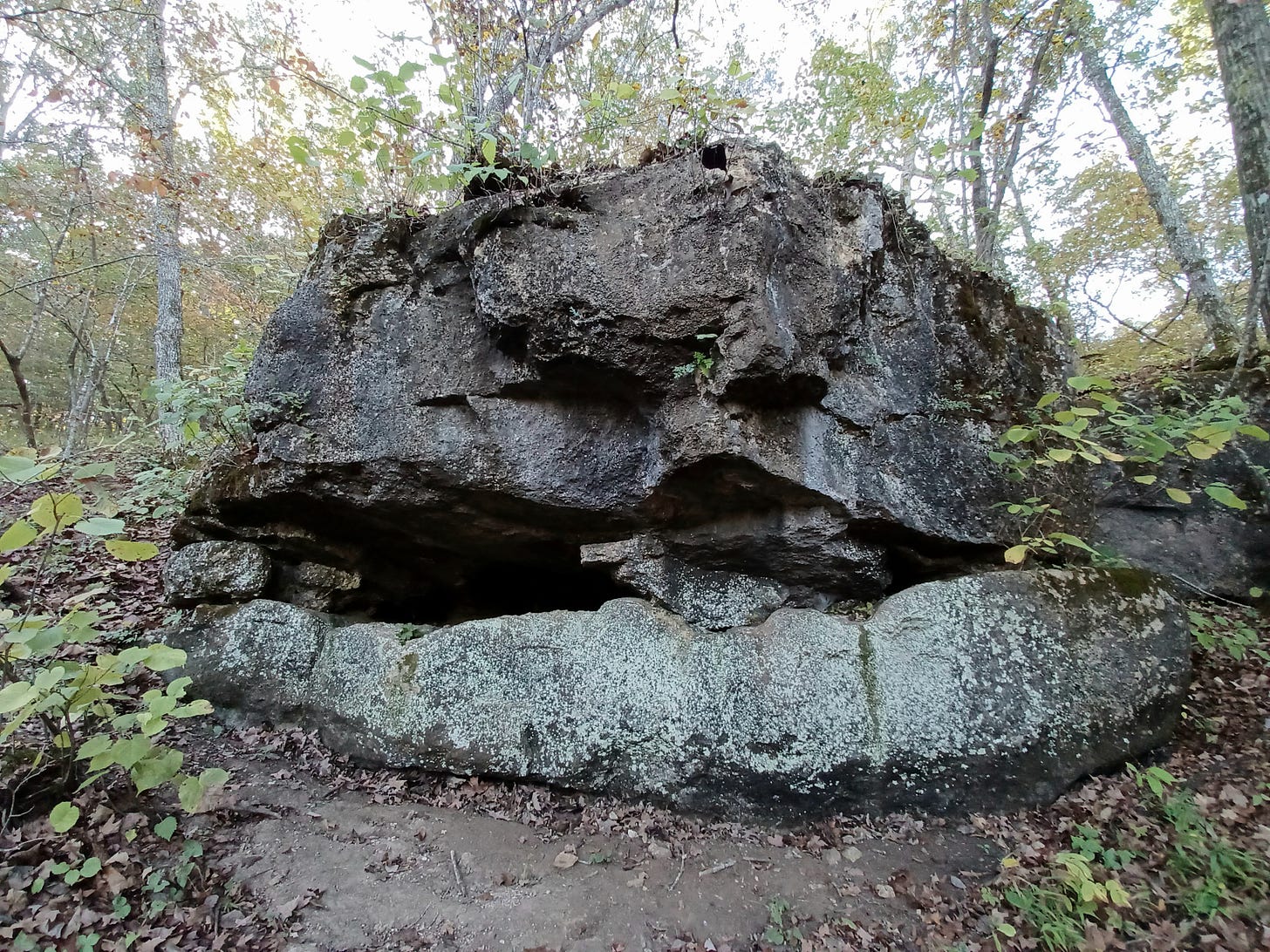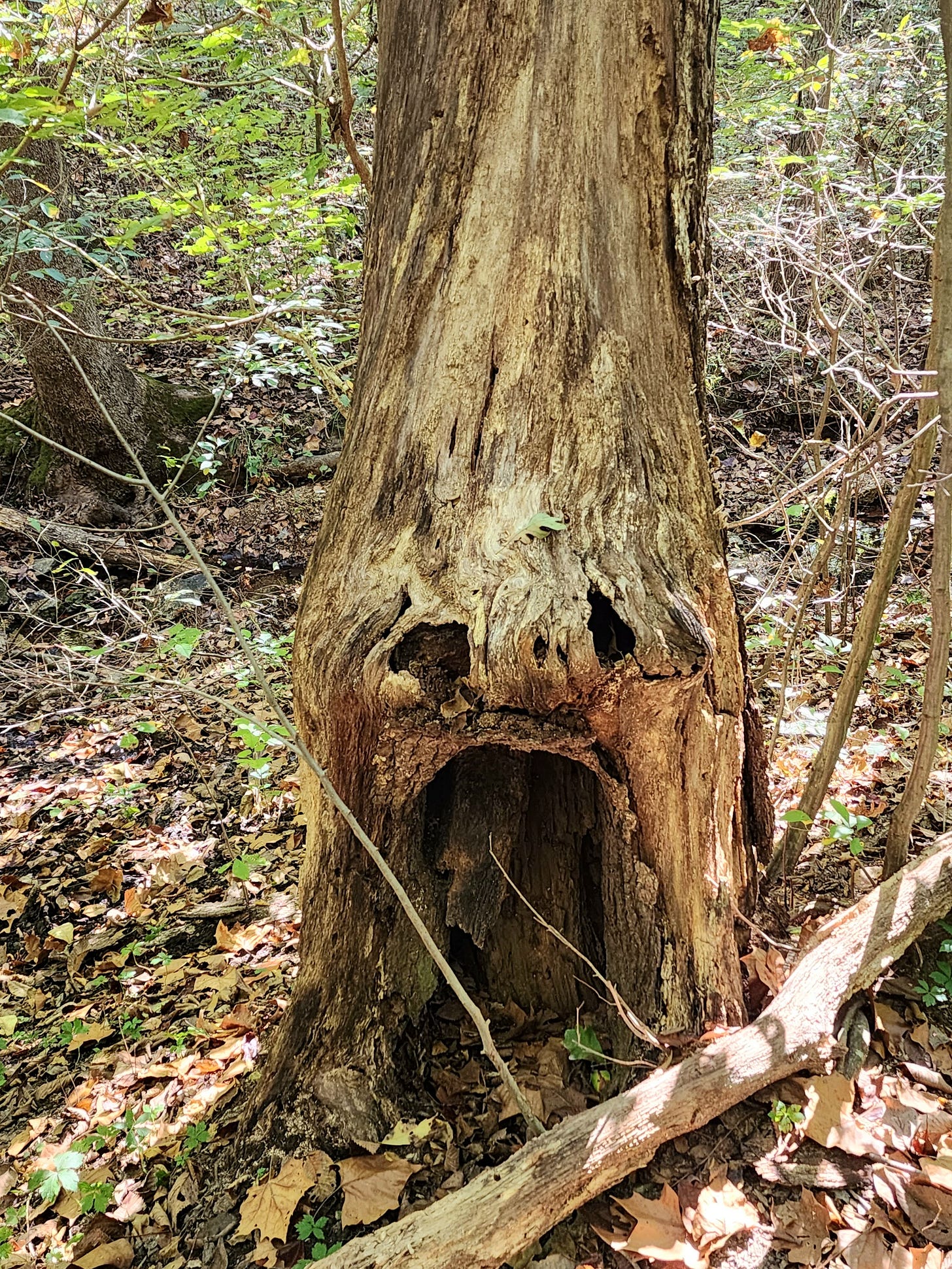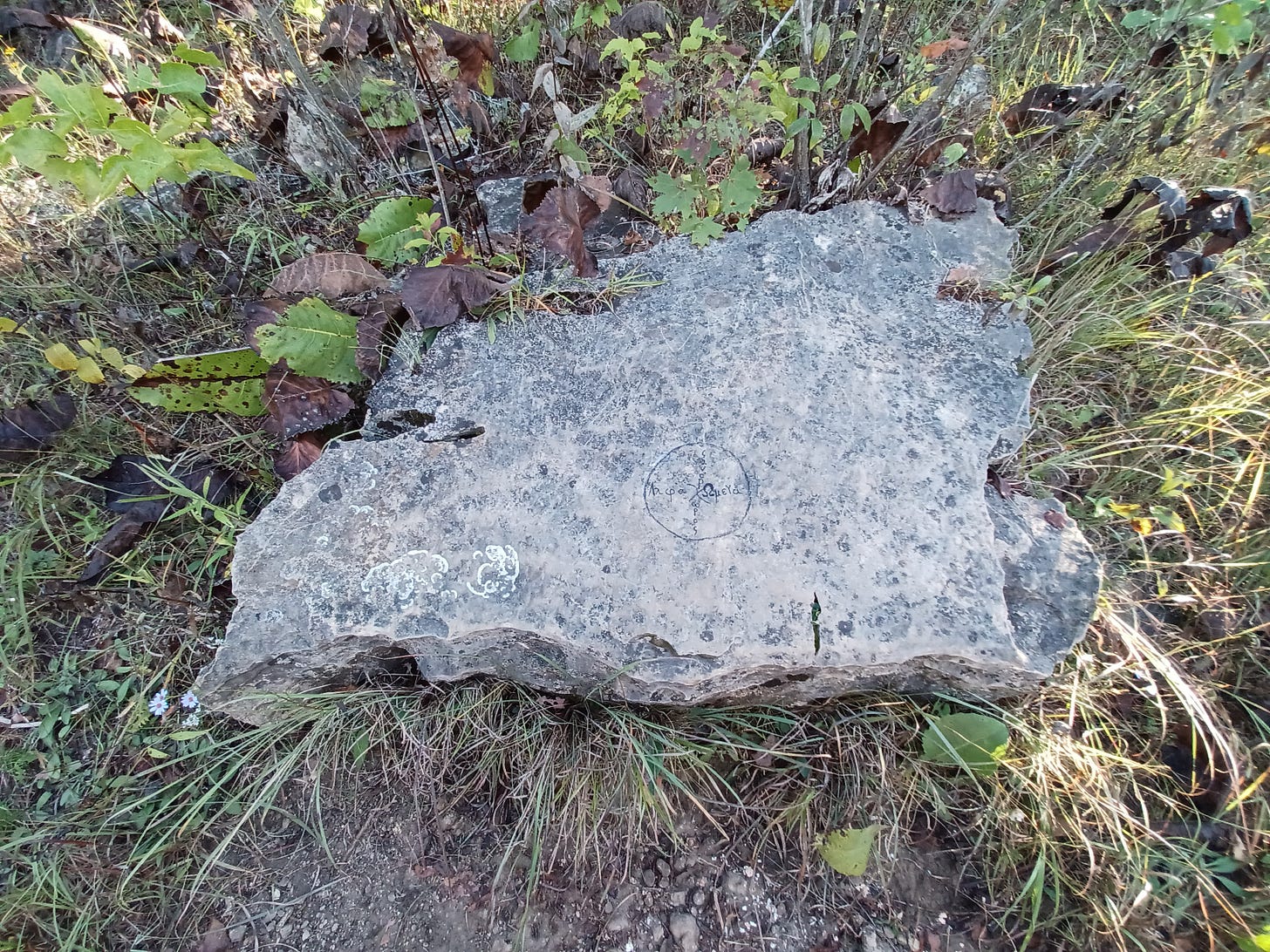In November 2019, I went for a walk in Mooner’s Hollow. Mooner’s Hollow is a bootlegging trail in the lead belt of Missouri a few miles away from an abandoned train tunnel said to be haunted by the spirits of slaves and thieves. I have never been to the tunnel because there is too much debate in Missouri about where private property begins and ends, and the concept of property extends to human beings. You do not know if you are exploring the wilderness or becoming someone’s future ghost.
I stayed instead on the old criminal’s trail and watched my children climb the half-billion-year-old boulders where gangsters hid their wares and cross the crystal-clear springs where murderers made their moonshine.
You know you are in the good part of Missouri when the ground sparkles as you walk. Mooner’s Hollow lies in the Ozark foothills, where quartz is embedded in the earth like fairy dust. When I’m sad, I like to dig for crystals near the ruins of a nearby mine, because I know it will deliver. When heartbreak drains your capacity for defeat, you crave the staged serendipity of a predictable surprise. There’s a guy who will take you out on an ATV and let you dig as much as you want so long as you bring a bucket and thirty dollars. I didn’t go there in 2019. Things were sad, but not as sad as to come.
I went there in 2023. I dug until my hands were red and I didn’t know if it was ore or blood. I returned home with a filth-covered haul. For weeks I would wake at dawn and go outside to strip away the iron and dirt, gloved with a bucket of chemicals and a toothbrush, baffling my neighbors. I cared for the minerals like you do for the very old, minding their fragility, trying to decipher their needs.
The biggest crystals line my backyard like porch lights timed to the sun. The little ones sit in egg cartons on a basement shelf. They need no fancy display. Minerals like that speak for themselves.
The bulk of my find is druzy quartz: a crystal discolored by history. A crystal that has seen too much. A crystal that took in so much dirt that the residue lives in its core. It shimmers, but a little darker than it used to. It gleams, but only if you show it the light, and then it sparkles, like it is remembering something. Sometimes druzy quartz looks like a cluster of bombs ready to explode, but they are solid. They got to the brink, and then they pulled back and stayed that way, hardened eternal in beautiful anger.
Missouri specializes in druzy quartz.
* * *
Too much happened since we last went to Mooner’s Hollow. My children have seen an unfinished plague, an unpunished coup, and four summers hotter than the summer before. They can read about the mass death of strangers through rectangles in their pockets and see death stalking the people they love in person. They learned about promises from politicians by the way they broke them. They learned about resilience on their own.
And they have seen a little light die out in my eyes, a darkness settling in, not illusory but hard like soil, the darkness of someone who spends too much time sifting through the dirt.
They know we have it easy compared to most — for now. They know the phrase “anything is possible” cuts both ways. They know the apocalypse rolls slow, and that their mother has learned to surf the blood-dimmed tide. They know that when people want to take your country and strip it down and sell it for parts, the safest parts may be the ones no one wants. They know that, in our land of caves and hollows, I know the best places to hide, and I will take them there, and keep them safe.
That’s what I tell them, anyway. I tell the public truth so blunt folks act like they’ve been stabbed with it. But when it comes to my children, I give it a little spin, a dash of what they call “Ozarks truth”. Tall tales and folklore and extended metaphors about nature, meant to stop words from becoming wounds.
Is it working yet?
* * *
I worry that by the time I post this two million people will be in the midst of being murdered. They are Palestinians in an open-air prison in Gaza, captives of a double-edged tyranny. They are ruled both by a terrorist government, Hamas, that the majority of Palestinians alive today did not elect, and by an Israeli apartheid mafia regime that has announced its intent to annihilate.
The Israeli government ignored the masses of Israeli protesters who denounced corruption, who warned that Netanyahu and his band of fanatics endanger Israeli lives too, and who were proven right in the worst of ways with last week’s horrific attack on Israeli civilians. Their captive Palestinian neighbors now face unparalleled brutality in the name of “retaliation”.
But the people most likely to be killed didn’t do anything.
There is a vast difference between a government and the people forced to live under it. If anyone should know that, it’s an American, yet false equivalencies abound. One should not equate Palestinians with Hamas, nor Israelis with Netanyahu’s regime. One should never cheer the death of a civilian, but it’s especially grotesque when so many victims are children. Nothing justifies the murder of a child. The people searching for rationales are committing an act of wartime surrender: the surrender of their souls. Israeli children were among those killed and captured in last week’s attack. And as I have noted, children have long been the greatest victims in Gaza.
Nearly half of Gazans are under eighteen. They have been living in caged conditions since 2007. A Palestinian teenager has no memory of another kind of life. Their parents hold memories of occupation, their grandparents hold memories of wars, their great-grandparents hold memories of the Nakba. The Israeli government holds some of the most advanced weaponry in the world, and memory is a primary target.
They ascribe collective guilt to justify annihilating collective memory.
Gazans saw catastrophe coming. They warned the world, and the world shrugged, or in the case of my country, funded the regime attacking them. Gazans are among the many targets of genocide who plead for aid and document their plight and then are chastised to sit quiet and wait. They are told to believe that the worst cannot happen.
And then, after the worst does happen, they are told that they deserve it. This is how the powerful excuse inaction. This is how they shed their accountability. They rewrite the present to bury the past and justify an irredeemable future.
Powerbrokers pretend time is not a weapon, but a neutral or even positive force: a force that benefits the bereft by giving them hope. They pretend that hope is not a weapon either. But hope is the deadliest weapon when wielded for decades without sincere intent. Hope without deeds is an empty cup that turns, over time, into a poisoned one. It poisons the people who drink it, and it poisons the people who proffer it, as they serve it up again and again.
* * *
On the Monday after the attack, I returned to Mooner’s Hollow. The kids were at school since genocidal sailor Christopher Columbus no longer gets a holiday for “discovering” indigenous people to massacre. It took all my life for that dark historical truth to be accepted. It makes you wonder how long it will take for other historical truths to be accepted as well. The answer is usually “when it’s too late”.
I walked slow and in silence. A trail never looks the same way twice. I climbed inside the crevice of a boulder and found a spider web filled with bumble bees suffocated in silk. I passed a large flat rock with Greek words written on it in the shape of a cross. “Alpha” on the left; “Omega” on the right. Vertically ran a Greek word for which I cannot find a translation, but the message was clear.
In early fall, Mooner’s Hollow fills with wildflowers: cornflower blue and magenta and yellow. On the top of a ragged white petal a soft fuzzy bee lay dead. I took a photo of it before I realized it was a corpse. At first, I was afraid to get close. I thought it was going to sting me. Then I wondered if it was sleeping, and gently moved the stem to rouse it. Then I realized it was no longer alive and was alarmed that I could not tell.
I read later that when a bee knows its life is ending, it retreats to a familiar flower. But it did not feel to me like this one’s time had come. I thought of the bees trapped in the web in the boulder’s narrow crevice, and how a scientist would say death is the natural order of things. And how the summer of 2023 was the hottest on record, so arid that the Mississippi River dried up for the second year straight, and how nothing feels natural or fair or right at all.
* * *
In Mooner’s Hollow, old memories return. On our 2019 visit, my family arrived on one of those bright blue November days when the thermometer says winter and the sun shines its rebuke. In these conditions, when the air and soil are just the right amount of cold and the plant life is amenable, a miracle happens. It’s called a frost flower.
A frost flower is a curling piece of ice that emerges from a plant when water is pushed through the stem and hits the frozen air. They grow in delicate spirals and last only hours before they melt, leaving no trace of their existence. I have seen them only a handful of times, and never when I was looking. The first time I saw frost flowers, I did not know what they were, and I touched one, destroying it. Now I tread with care, because I don’t want to miss them, and I do not want others to either. I want people to see that anything is possible.
Mooner’s Hollow is in a region notorious for having soil so rocky folks say you can’t raise anything but hell. People seeking hell came here: bootleggers, mining corporations, soldiers fighting for the wrong side. There are endless tales of ghosts because there are endless unresolved atrocities. There are endless trails because people never stopped seeking a way out.
You search the earth for something strong and reassuring, something that will stand by you when the world falls apart. Ancient rocks that bear the scars of history, crystals that conceded their beauty to preserve unsightly truth. But what stirs your soul is often gentle and fleeting. You find the first frost flower and follow a trail of them, each a unique twist on a theme. Your children shriek with delight at this unexpected treat. You marvel at your family’s chance arrival: What luck did it take to be there, at that precise moment, and have this happen?
And later, as you look across the world in anticipatory grief for the children of others, for the parents who kept seeking a way out and never found one, you ask the same question: What luck did it take to be there, at that precise moment, and have this happen?
(Mooner’s Hollow, Missouri, 2019 and 2023)








Sarah, most people would see me as a cold, overly rational old white man. Even my best friend calls me a Curmudgeon. But, here I sit, tears streaming, attempting to hold back uncontrollable sobbing. Since discovering you in 2016, you’ve been my Go-To for intelligent analysis, compassion and hope in this mad world. The paragraph that begins with “A frost flower…” and ends with “I want people to see that anything is possible.” reminded me of the Coda: In Defense of Complaining from your extraordinary first book, A View From Flyover Country.
I’m a Gaslit Nation Patreon supporter. I’ve missed you these past few months. Thank you so much.
Sarah Kendzior. I am so grateful for your profound observations, mind and truth telling. My heart, my tears, my grief stands with you. Thank you for your clear, sharp eye and unwavering commitment to the story. ❣️sending you so much love.